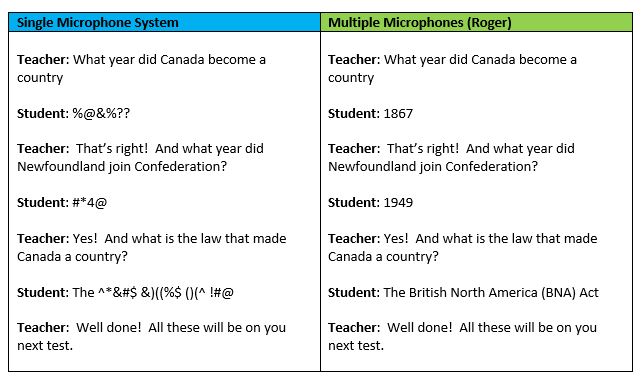
Roger™ versus non-adaptive remote microphones – What’s the difference?
Choosing a remote microphone system for the classroom should be done by considering the functional needs of the student with hearing loss. Drawing upon empirical evidence, professional knowledge, and the author’s own personal experiences as an audiologist with profound hearing loss, Peter Stelmacovich shows the differences in performance that can be expected from these different technologies.
Hearing care professionals and educators today are faced with a much wider choice of remote microphone technologies than ever before. However, it is important for professionals to understand the differences between these microphones in order to make an informed choice. The best way to assess the appropriateness of a remote microphone should be done in the context of the functional needs of the student with hearing loss.
The types of remote microphones available can be classified into two main categories: Phonak Roger, which is an adaptive digital transmission and a non-adaptive remote microphones. Adaptive digital transmission systems such as Roger measure the ambient room noise and the level of the speaker’s voice and adjust the gain of the receiver in order to achieve higher signal to noise ratios. Non-adaptive systems, which include Bluetooth microphones provide a fixed gain and do not adapt to room noise. As such the SNR achieved will be lower.
The specific microphones that will be reviewed include the following commonly used adaptive digital microphones:
- Phonak Roger Touchscreen
- Phonak Roger Select
- Phonak Roger Pen
For the non-adaptive remote microphones, the following were analyzed:
- Phonak Partner Mic
- Competitor Bluetooth microphone A
- Competitor Bluetooth microphone B
Listening needs of students
What are the listening needs of a student? We know that the student needs to be able to hear and understand the classroom teacher. However, teaching has changed over the past 25 years. No longer do children sit in rows of desks with the teacher primarily presenting the material. There is greater emphasis on interactive learning, student participation, group work, and use of technologies. When analyzing the acoustics of a child’s day in school, Phonak researchers found that only 22% of a child’s day was spent listening to frontal instruction from a teacher.1
The list below highlights potential listening needs for a student in today’s educational setting. When deciding on a remote microphone system, one should consider the extent to which the remote microphone system adequately meets these requirements in order to achieve equal access.
Need 1: Comprehending single teacher over distance and noise
It is well documented that classrooms are noisy environments.2 Moreover, the effects of distance and reverberation further degrades speech comprehension in all students. In addition, students with hearing loss require higher signal to noise ratios (SNR) than their typical hearing peers. As the hearing loss becomes more significant, the required SNR to understand speech also increases. This has been the reason for the use of remote microphone systems in schools for many years now.
All wireless systems reviewed have the capacity to transmit the teachers voice over distance. However, the adaptive Roger systems deliver the teachers voice at a higher SNR since the microphone measures the ambient room noise during pauses in the teacher’s speech and adjusts the receiver gain accordingly.3
Need #2: Adapting to changing classroom noise levels
Classroom noise levels are not static, in fact they are constantly changing. One study found that classroom noise levels range from 52 dB SPL during silent reading up to 77 dB SPL during group work.4 The remote microphone system needs to be able to handle all levels of classroom noise.
Additional research has shown significantly greater speech understanding with an adaptive digital system such as Phonak Roger compared to nonadaptive systems.5,6 In fact, one company published speech perception results at various noise levels and only showed around a 32%-word identification score at 75 dB compared to almost 70%-word identification when using an adaptive digital system such as Roger.5,7
These results clearly indicate that the 3 Roger systems with adaptive gain can address the problem of fluctuating classroom noise levels. None of the non-adaptive and Bluetooth microphone systems can adapt to the classroom noise levels and could result in reduced student comprehension compared to using a Roger system.
Need #3: Understanding during team teaching
Some classrooms use team teaching either on a regular basis, or intermittently such as when a special speaker comes to class or during student presentations. The student with a hearing loss also has a right to hear and understand any person who addresses the class. As such the remote microphone system needs to have the capability of being able to use multiple remote microphones that can capture all talkers in the classroom.
Returning to our review of the 6 microphone systems, all the Phonak Roger microphones can have 10 or more microphones working together in a network. Moreover, these microphones cannot all be active at the same time as this will result in unwanted noise being transmitted to the students with hearing loss. The Roger microphone systems are well designed such that the multiple microphones are voice activated resulting in only one talker being transmitted at a time. The Roger Touchscreen mic also allows for a mixing of the main teacher mic and one additional microphone (e.g. a Pass-around Mic) to be blended for a smoother transition between talkers. Note that all other mics will remain on standby, thus continuing to ensure a high SNR. None of the non-adaptive and Bluetooth systems reviewed can meet this need.
Need #4: Understanding classmates
Today’s classrooms are highly interactive environments in which participation from other classmates is encouraged. The student with hearing loss needs to be able to comprehend classmates as well as the teacher in order to have a fulsome educational experience.
Consider the following theoretical exchange between a teacher and a student might be like for a student with hearing loss. This has been the experience of this author when attempting to comprehend speech in a classroom both with and without the use of multiple microphones.
Therefore, a multiple microphone system is a mandatory requirement. Only the Roger microphone systems reviewed meet this need, compared to none of the Bluetooth microphones.
Need #5: Comprehending during group work in noise
Group work, in which students complete tasks in small groups of 4-5, is an important part of the student’s day and is by far one of the most challenging listening situations. Given that there are multiple conversations occurring simultaneously, the noise levels within the classroom are at their highest at this time. High noise levels result in a poor SNR and a corresponding decline in comprehension.
In order to improve speech comprehension in a group, Phonak developed a rotating directional microphone system that automatically changes its directivity based on the person who was speaking. This feature is only available in the Roger Touchscreen and Select microphones.
Need #6: Accessing multimedia content
Technology is an extremely important part of today’s modern classroom. These include white boards, computers, tablets, and television. There are numerous solutions available for students with hearing loss, including direct streaming to the hearing devices, the use of streamers as an intermediary device, direct connection to the remote microphone. With the exception of the Phonak Partner Mic, all the remote microphones reviewed have some audio input capability. However, the Phonak Touchscreen mic can be combined with a Multimedia Hub which will allow the teacher to continue to use the Touchscreen Mic to make comments on material while the Multimedia hub will deliver a high-quality signal to the student with hearing loss.
Need #7: Listening in different social situations
School is more than just about learning in classroom. Communication with peers during non-class activities is crucially important for the students affective (emotional) development. An ideal wireless mic system should be able to be used in multiple listening environments, not just the classroom.
All the remote microphones reviewed can meet this need and can be used in a one-one conversation with a peer, however, only the Touchscreen and Select microphones have automatic rotating directional microphones that will improve the SNR in a group situation.
Need #8: Listening in gymnasium/large assemblies
During assemblies in the school gymnasium or auditorium, the distance between the talker and the student is even greater than in the classroom resulting in an even lower SNR. At issue here is the transmission distance of the remote microphone system. Generally, Bluetooth microphones have a reduced transmission range making them effective at a distance of 20 meters or less.8 Roger Touchscreen has a range of 50 meters in general. If greater range is required, then additional range extenders (Roger Repeater) can be added.
Need #9: Soundfield compatibility
An ideal system should meet the needs of universal design, that is, it should be able to meet the needs of all students in the classroom. Classroom amplification systems, also known as sound field systems, are designed primarily for students with typical hearing. Some may have audio output capabilities, however, when patching an adaptive remote microphone system to these sound field systems the adaptive features do not work resulting in poor SNR at higher noise levels. The only microphone system reviewed that is compatible with both personal hearing aids and sound field systems is the Touchscreen microphone.
Need #10: Compatibility with multiple hearing aid and cochlear implant brands
An ideal system should be compatible with all hearing aids and cochlear implants. The Phonak Roger microphones have receivers compatible with almost all hearing devices currently available.
Contrast this with Bluetooth microphones that are compatible with only one manufacturer. There is no Bluetooth microphone for all makes of hearing aids. In the event that there are several students in the class, or school with hearing loss using different makes of hearing aids, the teacher will be required to wear multiple microphones simultaneously. With the three Roger remote systems reviewed, the teacher only needs to wear one microphone to transmit to any number of students with hearing loss.
In summary, only the Phonak Roger Touchscreen remote microphone system can meet all the needs of a student in the classroom. The Roger Select and Pen microphones can meet most of the needs, but not all. None of the non-adaptive and Bluetooth microphones reviewed adequately meet the needs as these are designed primarily to be used for only one talker.
References
- Feilner, M., Rich, S., & Jones, C. (2016). Automatic and directional for kids – Scientific background and implementation of pediatric optimized automatic functions. Phonak Insight, retrieved from www.phonakpro.com/evidence, accessed July 31st, 2020.
- Sheild, B. M. (2008). The effects of environmental and classroom noise on the academic attainments of primary school children. The Journal of the Acoustical Society of America, 123- 133.
- Phonak (2013). Roger Pen: Bridging the understanding gap. Phonak Insight. Retrieved July 31st 2020, from https://www.phonakpro.com/content/dam/phonakpro/gc_hq/en/resources/evidence/white_paper/documents/technical_paper/Insight_Roger_Pen_028-0933.pdf.
- Sheild, B., & Julie, D. (2003). The effects of classroom noise on children’s academic attainments. White paper. Retrieved July 31st 2020, from http://mail.sea-acustica.es/fileadmin/publicaciones/Sevilla02_rba08004.pdf.
- Thibodeau, L. (2014). Comparison of speech recognition with adaptive digital and FM remote microphone hearing assistance technology by listeners who use hearing aids. American Journal Of Audiology, 23(2), 201-210.
- Wolfe, J., Morais, M., Schafer, E., Mills, E., Peters, R., & Lianos, L. et al. (2013). Better speech recognition with Digital RF system in study of cochlear implants. The Hearing Journal, 66(7), 24-26.
- Oticon. (2020). Enhanced learning with EduMic White Paper 2019. Retrieved July 9th, 2020, from https://wdh02.azureedge.net/-/media/oticon-us/main/download-center—myoticon—product-literature/whitepapers/20-16524-15555-9925-edumic-whitepaper.pdf?rev=964B&la=en
- Oticon (2020). EduMic FAQ. Retrieved July 9th 2020, from https://www.oticon.ca/hearing-aid-users/support/faq/edumic.

